Prediction of the Mechanical Performance of Cemented Tailings Backfill Using Ultrasonic Pulse Velocity Measurement
Abstract
:1. Introduction
2. Theoretical Base of the Measurement
3. Materials and Methods
3.1. Materials and Properties
3.2. Specimen Preparation
3.3. Test Process
3.3.1. Ultrasonic Test
3.3.2. Uniaxial Compressive Strength (UCS) Test
3.3.3. Microstructure Tests
4. Results and Discussions
4.1. UPV Development of CTB during the 28-Day Curing Age
4.2. UCS Development of CTB during 28-Day Curing Age
4.3. The Microstructure Evolution of CTB Samples
4.4. Correlation of the UCS and UPV of CTB Samples
5. Conclusions
Author Contributions
Funding
Data Availability Statement
Acknowledgments
Conflicts of Interest
References
- Yılmaz, T.; Ercikdi, B.J.N.T. Predicting the uniaxial compressive strength of cemented paste backfill from ultrasonic pulse velocity test. Nondestruct. Test. Eval. 2016, 31, 247–266. [Google Scholar] [CrossRef]
- Trtnik, G.; Valič, M.I.; Kavčič, F.; Turk, G.J.C. Comparison between two ultrasonic methods in their ability to monitor the setting process of cement pastes. Cem. Concr. Res. 2009, 39, 876–882. [Google Scholar] [CrossRef] [Green Version]
- Stepisnik, J.; Lukac, M.; Kocuvan, I. Measurement of Cement Hydration by Ultrasonics. Am. Ceram. Soc. Bulletin. 1981, 60, 481–483. [Google Scholar]
- Valič, M.J.C.; Research, C. Hydration of cementitious materials by pulse echo USWR: Method, apparatus and application examples. Cem. Concr. Res. 2000, 30, 1633–1640. [Google Scholar] [CrossRef]
- Akkaya, Y.; Voigt, T.; Subramaniam, K.; Shah, S.P.J.M. Nondestructive measurement of concrete strength gain by an ultrasonic wave reflection method. Mater. Struct. 2003, 36, 507–514. [Google Scholar] [CrossRef]
- Voigt, T.; Malonn, T.; Shah, S.P.J.C.; Research, C. Green and early age compressive strength of extruded cement mortar monitored with compression tests and ultrasonic techniques. Cem. Concr. Res. 2006, 36, 858–867. [Google Scholar] [CrossRef]
- Voigt, T.; Sun, Z.; Shah, S.P.J.C.; Composites, C. Comparison of ultrasonic wave reflection method and maturity method in evaluating early-age compressive strength of mortar. Cem. Concr. Compos. 2006, 28, 307–316. [Google Scholar] [CrossRef]
- Sun, Z.; Voigt, T.; Shah, S.P.J.C.; Research, C. Rheometric and ultrasonic investigations of viscoelastic properties of fresh Portland cement pastes. Cem. Concr. Res. 2006, 36, 278–287. [Google Scholar] [CrossRef]
- Sun, Z.; Ye, G.; Voigt, T.; Shah, S.P.; Van Breugel, K. Early Age Properties of Portland Cement Pastes Investigated with Ultrasonic Shear Waves and Numerical Simulation. In Proceedings of the RILEM International Symposium on Advances in Concrete through Science and Engineering, Evanston, IL, USA, 21–24 March 2004. [Google Scholar]
- Krauß, M.; Hariri, K.J.C.; Composites, C. Determination of initial degree of hydration for improvement of early-age properties of concrete using ultrasonic wave propagation. Cem. Concr. Compos. 2006, 28, 299–306. [Google Scholar] [CrossRef]
- Ye, G. Experimental Study and Numerical Simulation of the Development of the Microstructure and Permeability of Cementitious Materials. Ph.D. Thesis, Delft University of Technology, Delft, The Netherlands, 2003. [Google Scholar]
- Ye, G.; Lura, P.; Van Breugel, K.; Fraaij, A.J.C.; Composites, C. Study on the development of the microstructure in cement-based materials by means of numerical simulation and ultrasonic pulse velocity measurement. Cem. Concr. Compos. 2004, 26, 491–497. [Google Scholar] [CrossRef]
- Robeyst, N.; Grosse, C.U.; De Belie, N.J.C.; Composites, C. Relating ultrasonic measurements on fresh concrete with mineral additions to the microstructure development simulated by Cemhyd3D. Cem. Concr. Compos. 2011, 33, 680–693. [Google Scholar] [CrossRef]
- Reinhardt, H.; Grosse, C.; Herb, A.J.M. Ultrasonic monitoring of setting and hardening of cement mortar—A new device. Mater. Struct. 2000, 33, 581–583. [Google Scholar] [CrossRef]
- Reinhardt, H.; Grosse, C.J.C. Continuous monitoring of setting and hardening of mortar and concrete. Constr. Build. Mater. 2004, 18, 145–154. [Google Scholar] [CrossRef]
- Reinhardt, H.-W.; Grosse, C.; Herb, A.; Weiler, B.; Schmidt, G. Method for Examining a Solidifying and/or Hardening Material using Ultrasound, Receptacle and Ultrasound Sensor for Carrying out the Method; US Patent and Trademark Office: Detroit, MI, USA, 2003. [Google Scholar]
- Yilmaz, E.; Belem, T.; Benzaazoua, M.J.E.G. Effects of curing and stress conditions on hydromechanical, geotechnical and geochemical properties of cemented paste backfill. Eng. Geol. 2014, 168, 23–37. [Google Scholar] [CrossRef]
- Yilmaz, E.; Belem, T.; Benzaazoua, M.J.E.G. Specimen size effect on strength behavior of cemented paste backfills subjected to different placement conditions. Eng. Geol. 2015, 185, 52–62. [Google Scholar] [CrossRef]
- Yilmaz, E.; Benzaazoua, M.; Belem, T.; Bussière, B.J.M.E. Effect of curing under pressure on compressive strength development of cemented paste backfill. Miner. Eng. 2009, 22, 772–785. [Google Scholar] [CrossRef]
- Benzaazoua, M.; Fall, M.; Belem, T.J.M. A contribution to understanding the hardening process of cemented pastefill. Miner. Eng. 2004, 17, 141–152. [Google Scholar] [CrossRef]
- Ercikdi, B.; Kesimal, A.; Cihangir, F.; Deveci, H.; Alp, İ.J.C.; Composites, C. Cemented paste backfill of sulphide-rich tailings: Importance of binder type and dosage. Miner. Eng. 2009, 31, 268–274. [Google Scholar] [CrossRef]
- Fall, M.; Célestin, J.; Pokharel, M.; Touré, M. A contribution to understanding the effects of curing temperature on the mechanical properties of mine cemented tailings backfill. Eng. Geol. 2010, 114, 397–413. [Google Scholar] [CrossRef]
- Trtnik, G.; Gams, M.J.C.; Research, C. The use of frequency spectrum of ultrasonic P-waves to monitor the setting process of cement pastes. Cem. Concr. Res. 2013, 43, 1–11. [Google Scholar] [CrossRef]
- Trtnik, G.; Turk, G.J.C.; Research, C. Influence of superplasticizers on the evolution of ultrasonic P-wave velocity through cement pastes at early age. Cem. Concr. Res. 2013, 51, 22–31. [Google Scholar] [CrossRef] [Green Version]
- Trtnik, G.; Valič, M.I.; Turk, G.J.N.; International, E. Measurement of setting process of cement pastes using non-destructive ultrasonic shear wave reflection technique. NDT E Int. 2013, 56, 65–75. [Google Scholar] [CrossRef] [Green Version]
- Del Rıo, L.; Jimenez, A.; Lopez, F.; Rosa, F.; Rufo, M.; Paniagua, J.J.U. Characterization and hardening of concrete with ultrasonic testing. Ultrasonics 2004, 42, 527–530. [Google Scholar] [CrossRef] [PubMed]
- Lago, S.; Brignolo, S.; Cuccaro, R.; Musacchio, C.; Albo, P.A.G.; Tarizzo, P. Application of acoustic methods for a non-destructive evaluation of the elastic properties of several typologies of materials. Appl. Acoust. 2013, 75, 10–16. [Google Scholar] [CrossRef]
- Landriault, D. IPaste backfill mix design for Canadian underground hard rock mining. In Proceedings of the 97th Annual General Meeting of CIM. Rock Mechanics and Strata Control Session, Halifax, NS, Canada, 14–18 May 1995. [Google Scholar]
- Landriault, D. Backfill in underground mining. Undergr. Min. Methods Eng. Fundam. Int. Case Stud. 2001, 601–614. [Google Scholar]
- Tian, X.; Fall, M. Non-isothermal evolution of mechanical properties, pore structure and self-desiccation of cemented paste backfill. Constr. Build. Mater. 2021, 297, 123657. [Google Scholar] [CrossRef]
- Voigt, T.J.P.T. The Application of an Ultrasonic Shear Waves Reflection Method for Nondestructive Testing of Cement-Based Materials at Eraly Ages. Ph.D. Thesis, Leipzig University, Leipzig, German, 2004. [Google Scholar]
- Feylessoufi, A.; Tenoudji, F.C.; Morin, V.; Richard, P.J.C. Early ages shrinkage mechanisms of ultra-high-performance cement-based materials. Cem. Concr. Res. 2001, 31, 1573–1579. [Google Scholar] [CrossRef]
- Ye, G.; Van Breugel, K.; Fraaij, A.J.C.; Research, C. Experimental study and numerical simulation on the formation of microstructure in cementitious materials at early age. Cem. Concr. Res. 2003, 33, 233–239. [Google Scholar] [CrossRef]
- Abdul-Hussain, N.; Fall, M. Unsaturated hydraulic properties of cemented tailings backfill that contains sodium silicate. Eng. Geol. 2011, 123, 288–301. [Google Scholar] [CrossRef]
- Fang, K.; Fall, M. Effects of curing temperature on shear behaviour of cemented paste backfill-rock interface. Int. J. Rock Mech. Min. Sci. 2018, 112, 184–192. [Google Scholar] [CrossRef]
- Ghirian, A.; Fall, M. Strength evolution and deformation behaviour of cemented paste backfill at early ages: Effect of curing stress, filling strategy and drainage. Int. J. Min. Sci. Technol. 2016, 26, 809–817. [Google Scholar] [CrossRef]
- Taylor, H.F. Cement Chemistry; Thomas Telford: London, UK, 1997; Volume 2. [Google Scholar]
- Xu, W.; Tian, X.; Cao, P. Assessment of hydration process and mechanical properties of cemented paste backfill by electrical resistivity measurement. Nondestruct. Test. Eval. 2018, 33, 198–212. [Google Scholar] [CrossRef]
- Trtnik, G.; Kavčič, F.; Turk, G.J.U. Prediction of concrete strength using ultrasonic pulse velocity and artificial neural networks. Ultrasonics 2009, 49, 53–60. [Google Scholar] [CrossRef] [PubMed] [Green Version]
- Demirboğa, R.; Türkmen, İ.; Karakoc, M.B.J.C. Relationship between ultrasonic velocity and compressive strength for high-volume mineral-admixtured concrete. Cem. Concr. Res. 2004, 34, 2329–2336. [Google Scholar] [CrossRef]
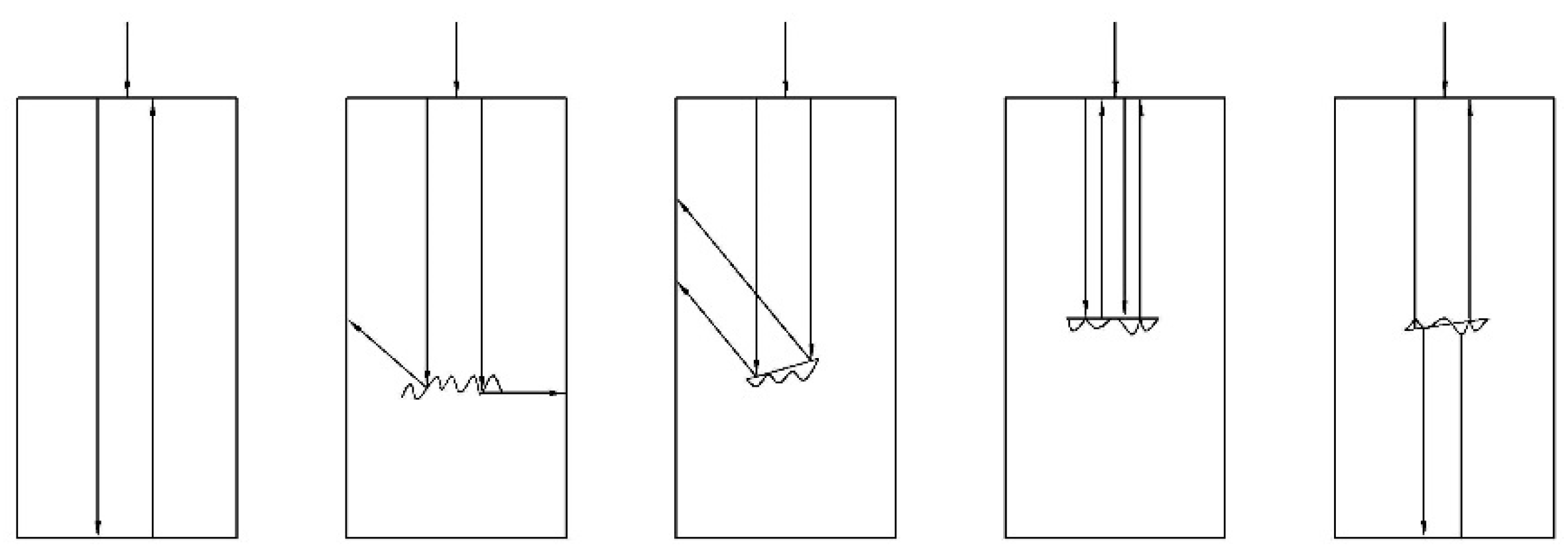
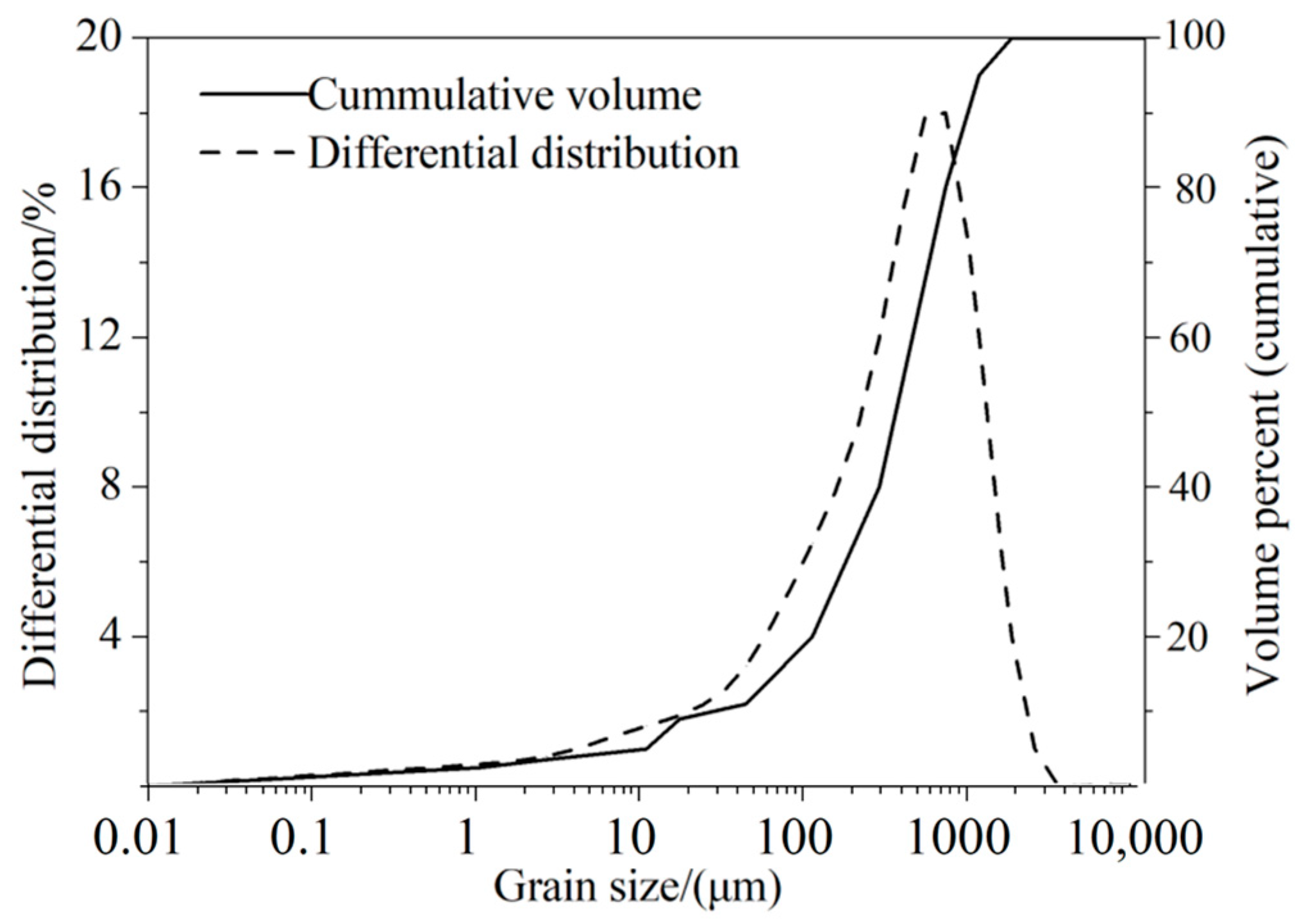

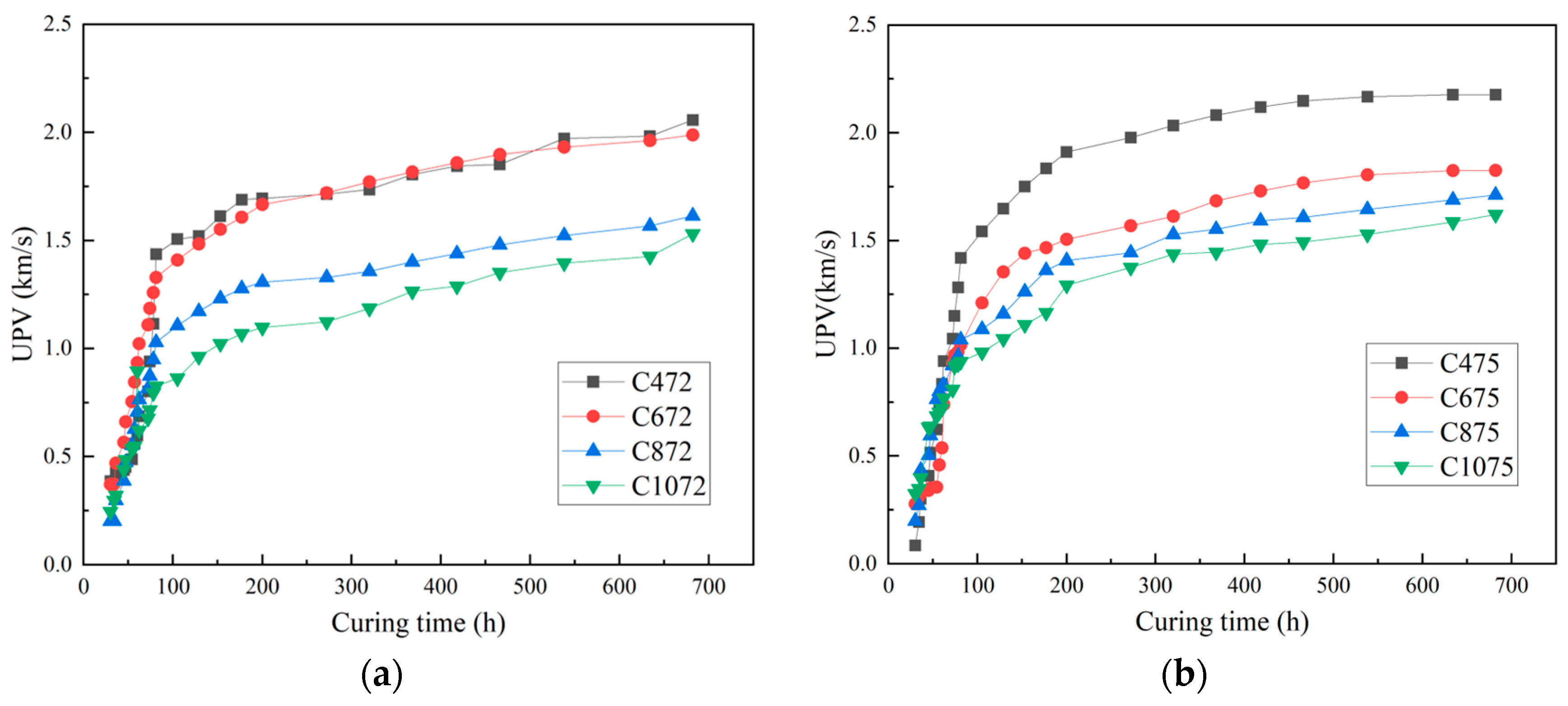
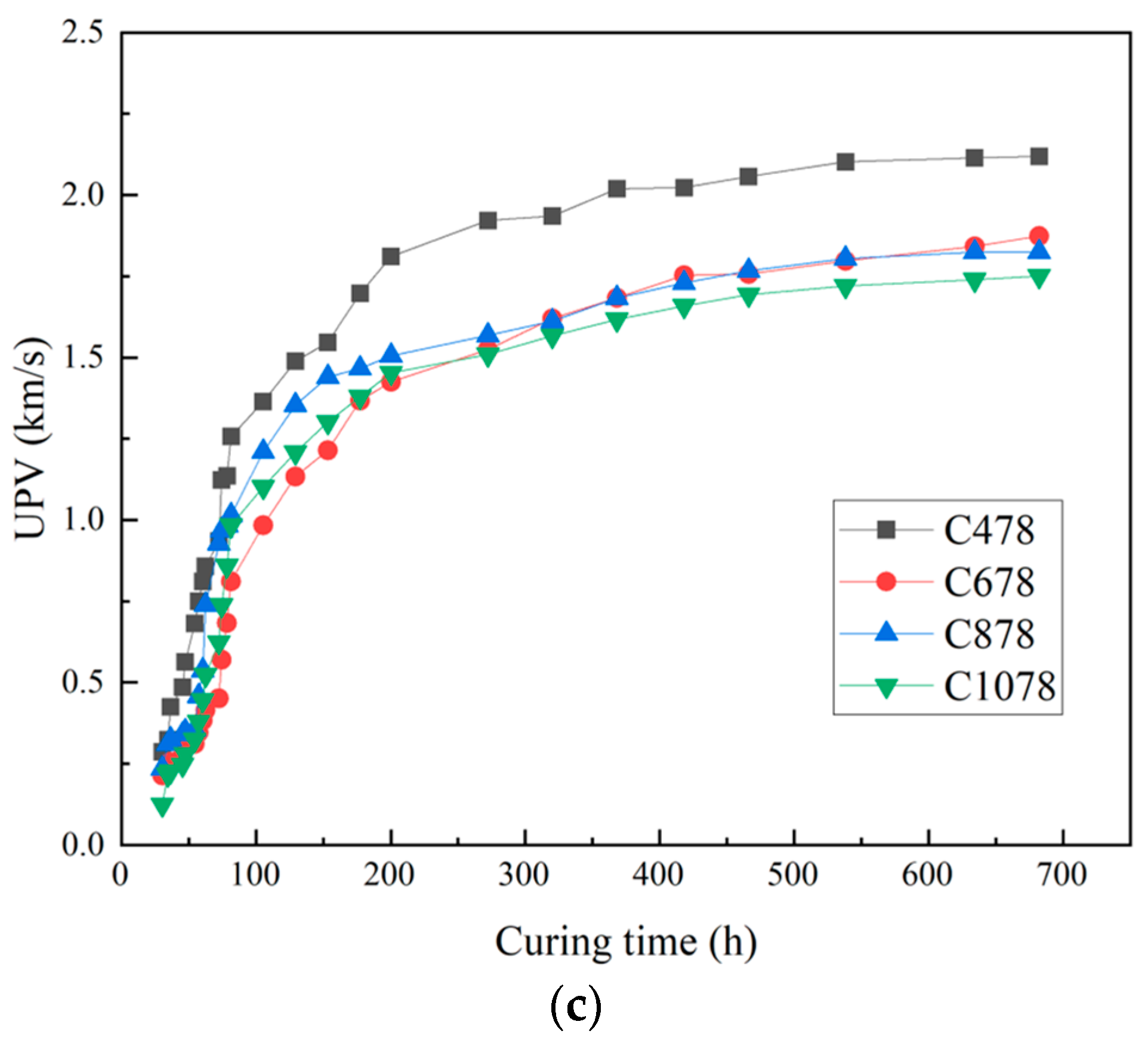
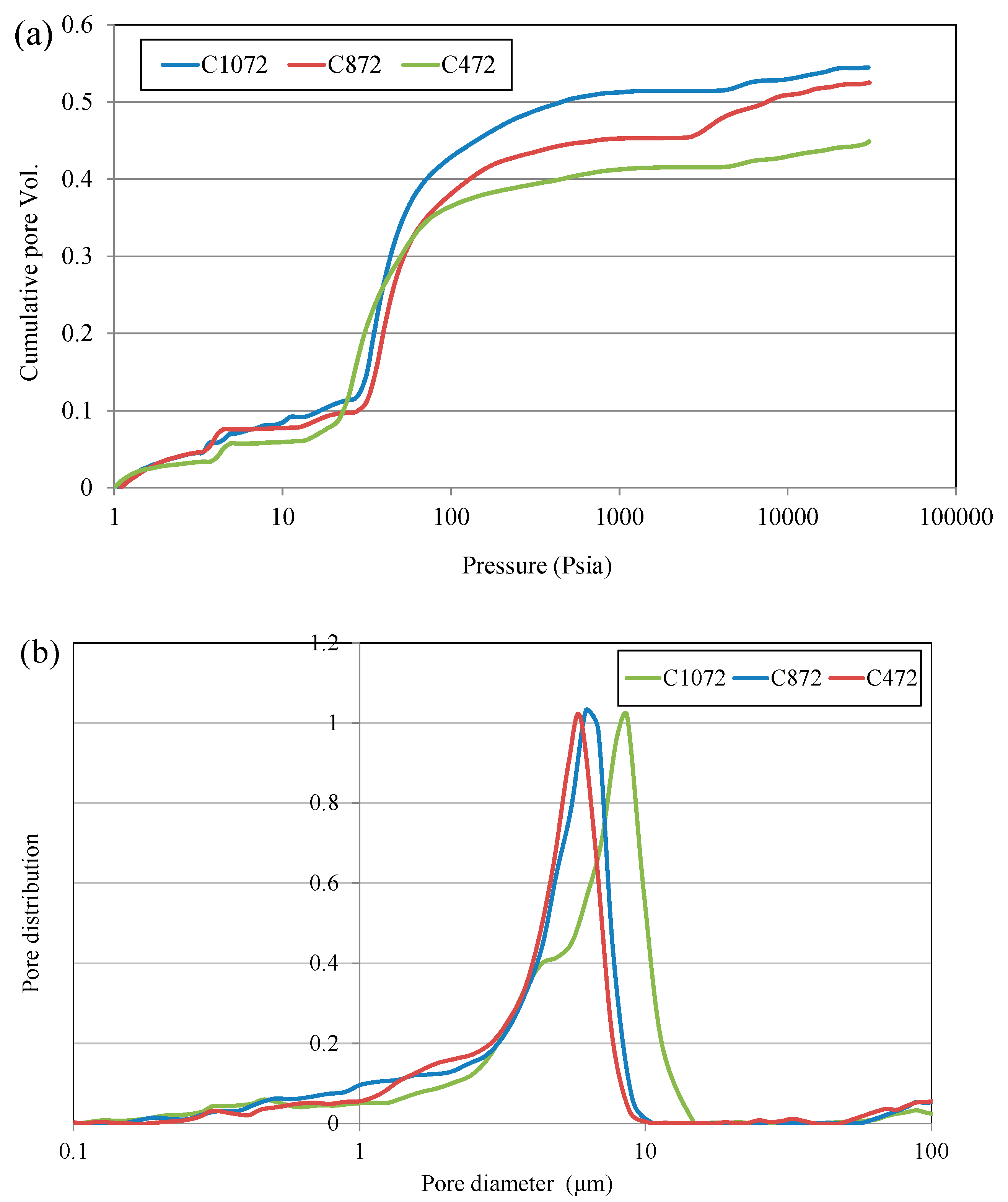
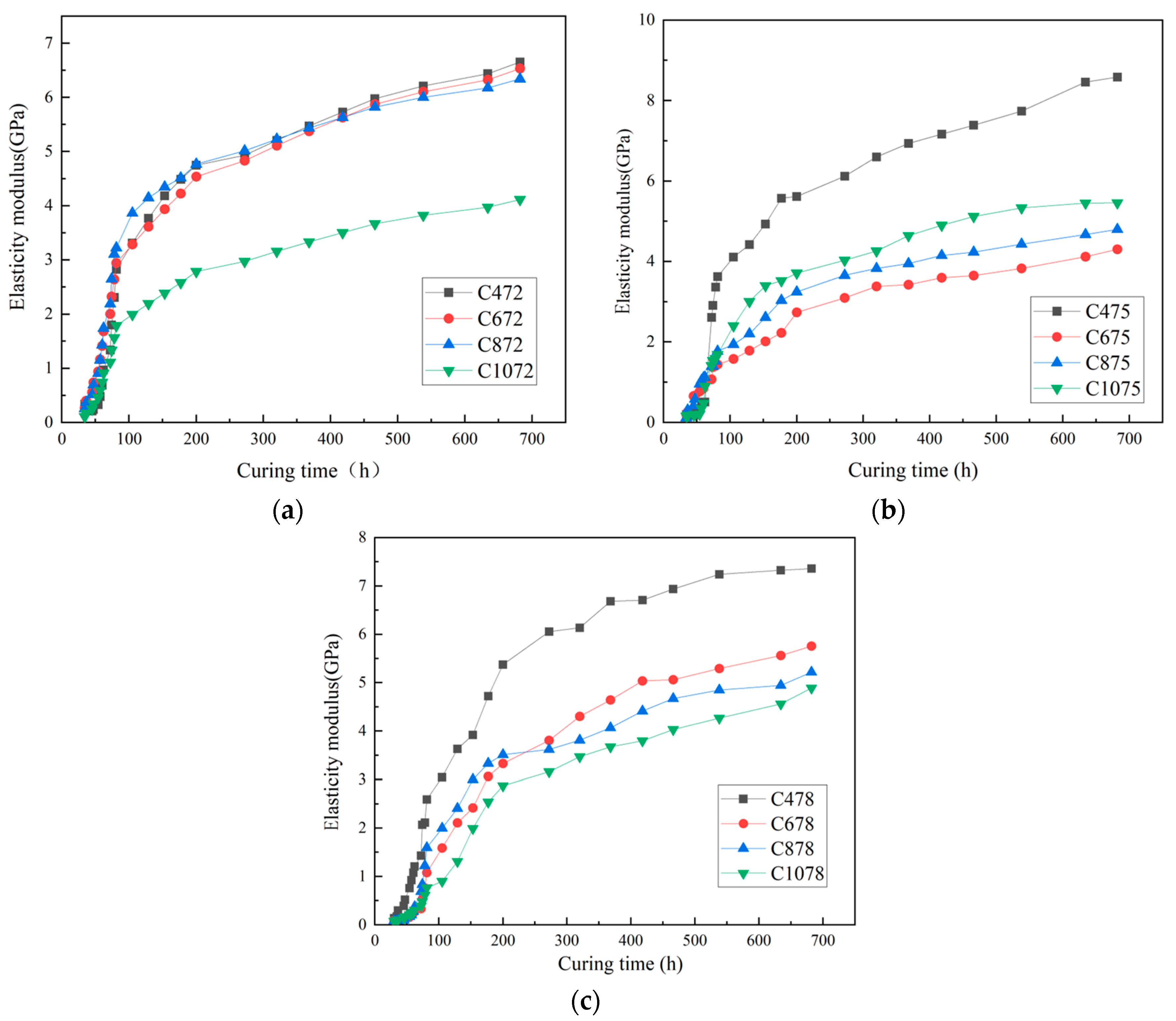
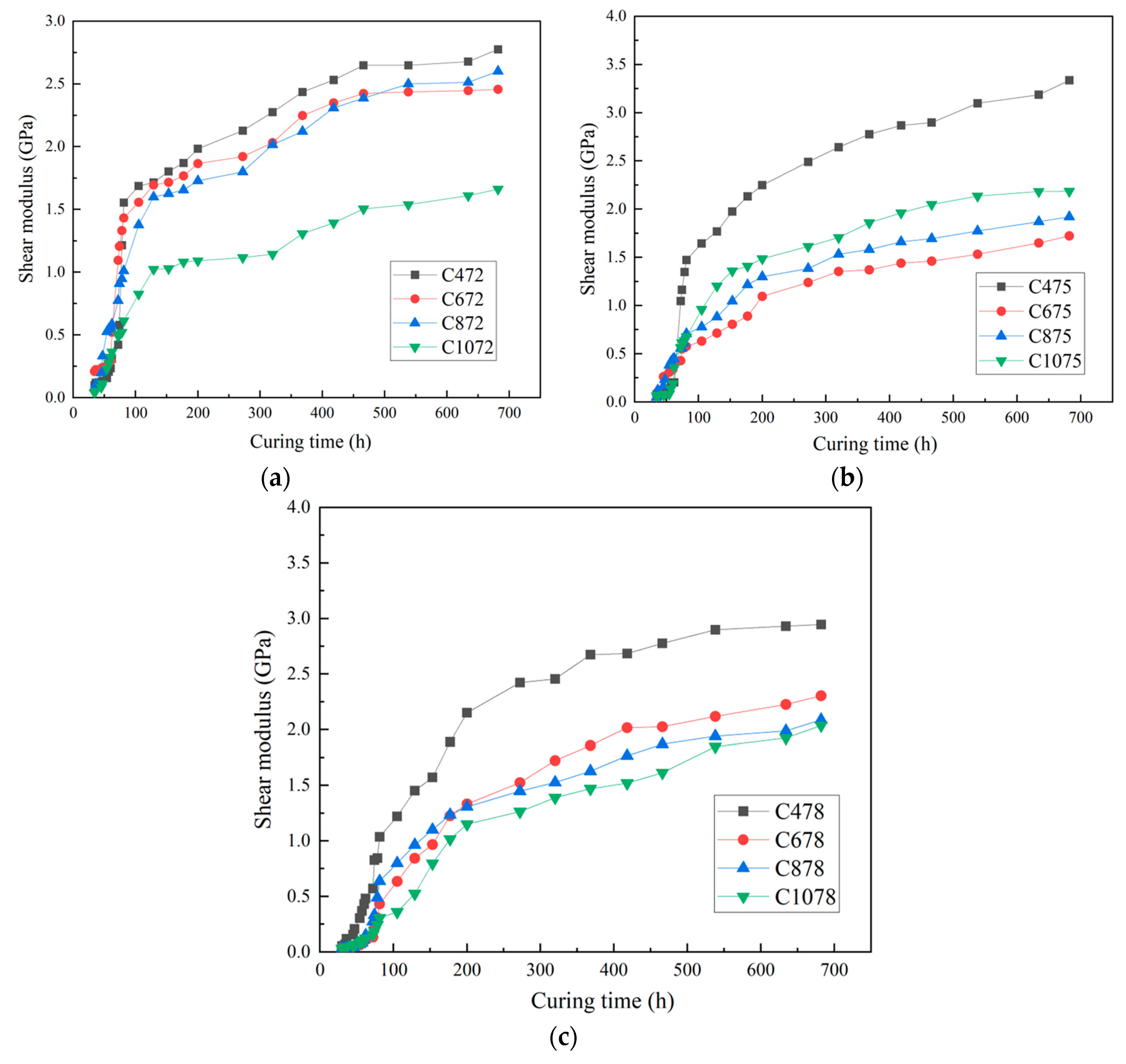
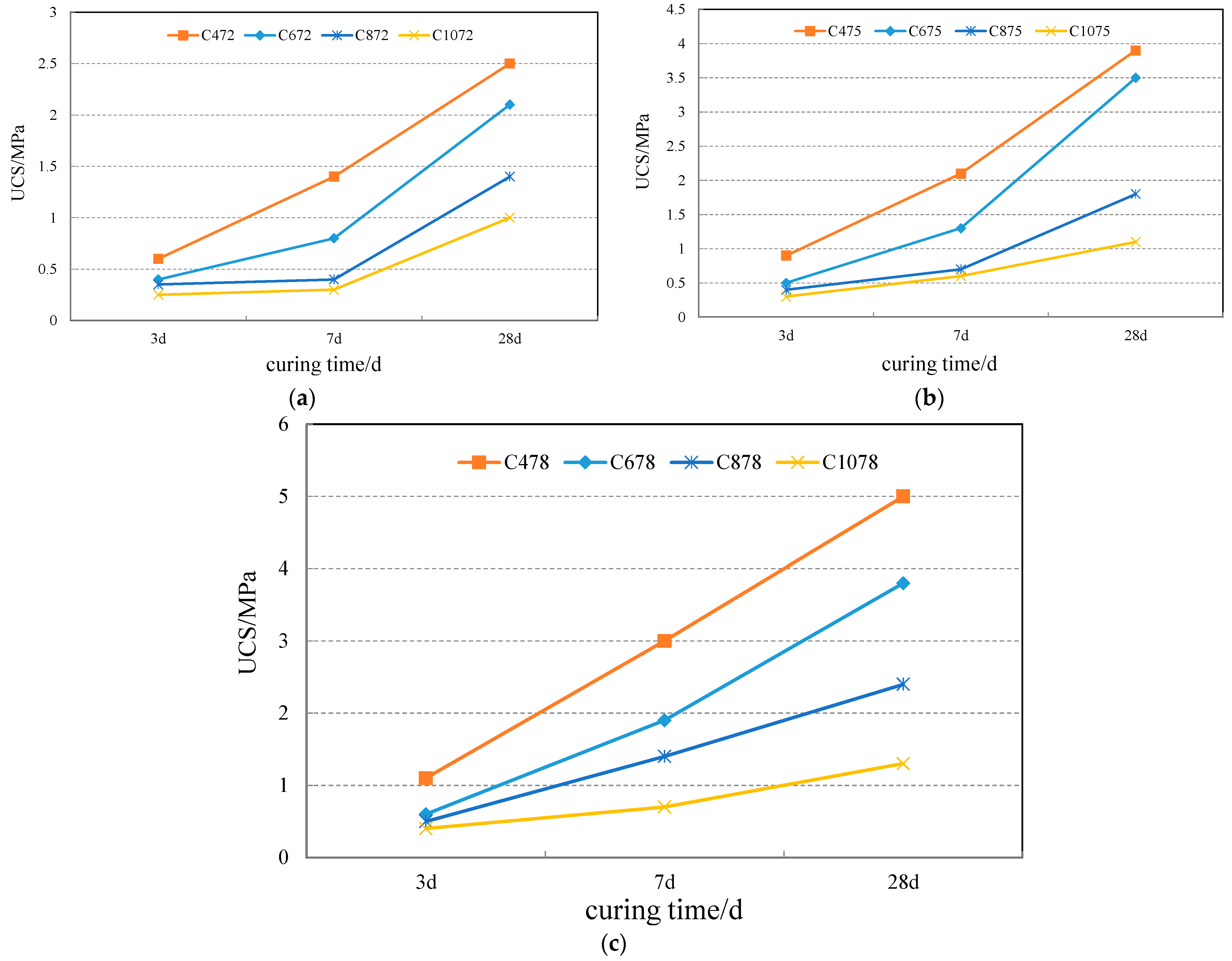
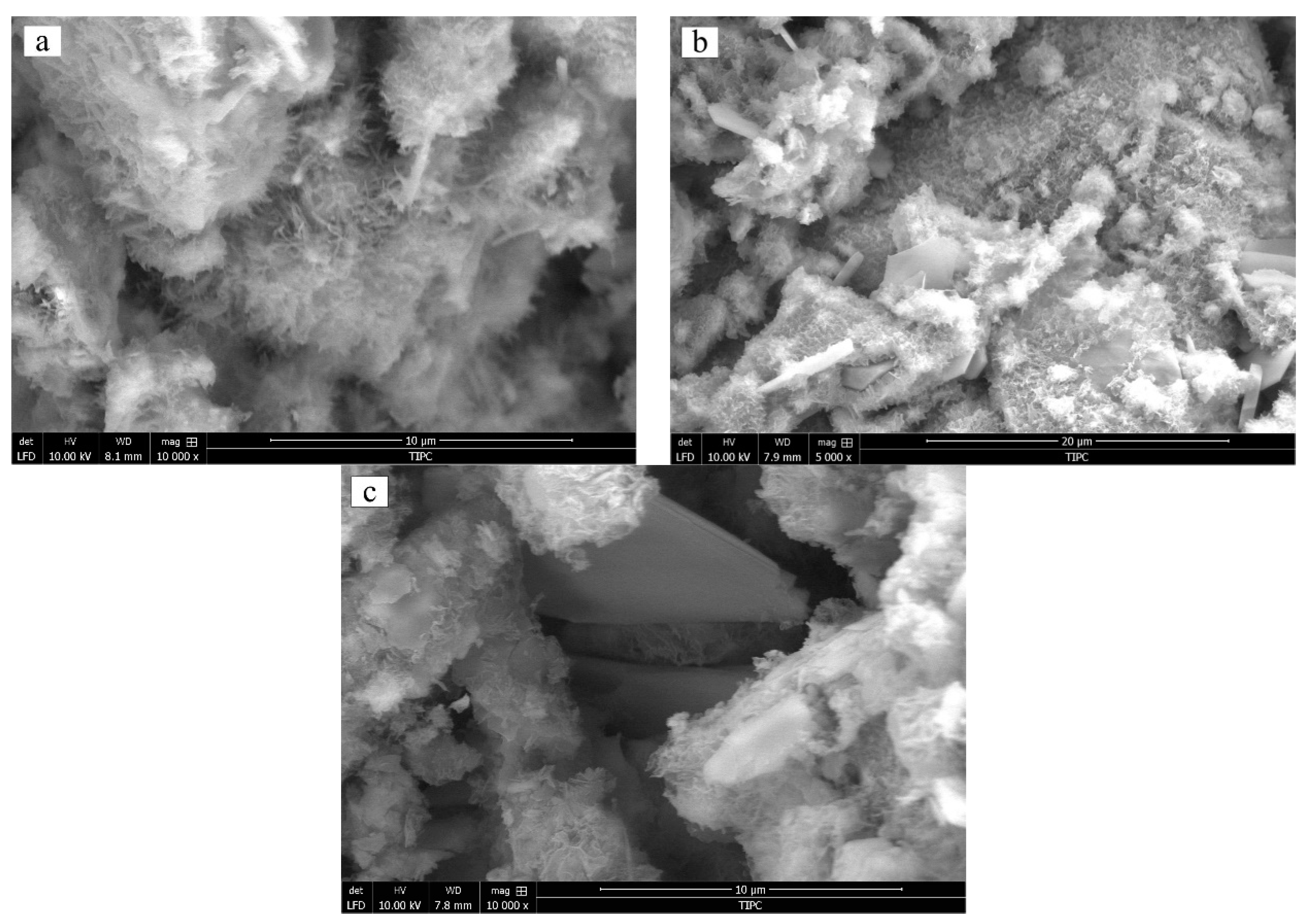
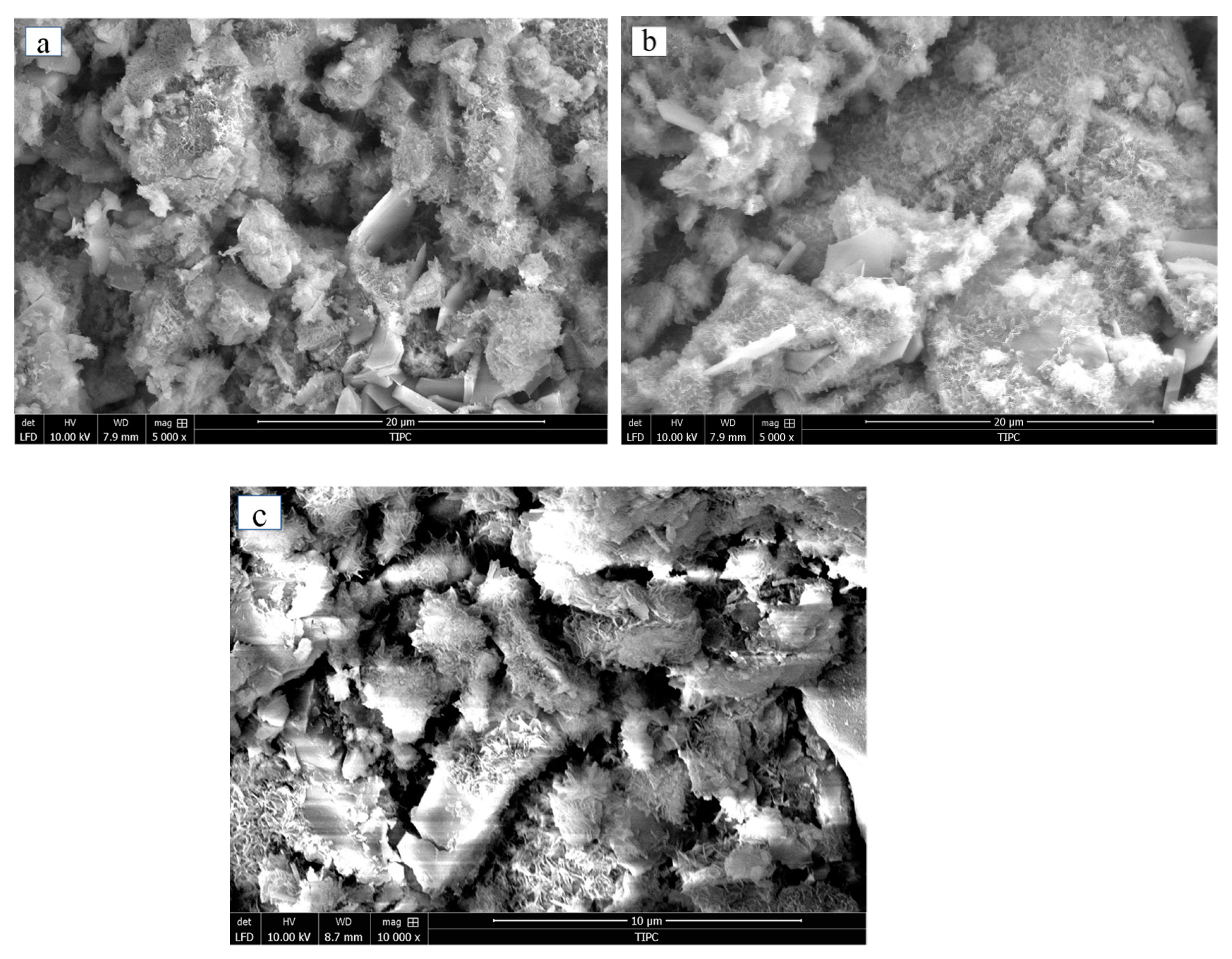

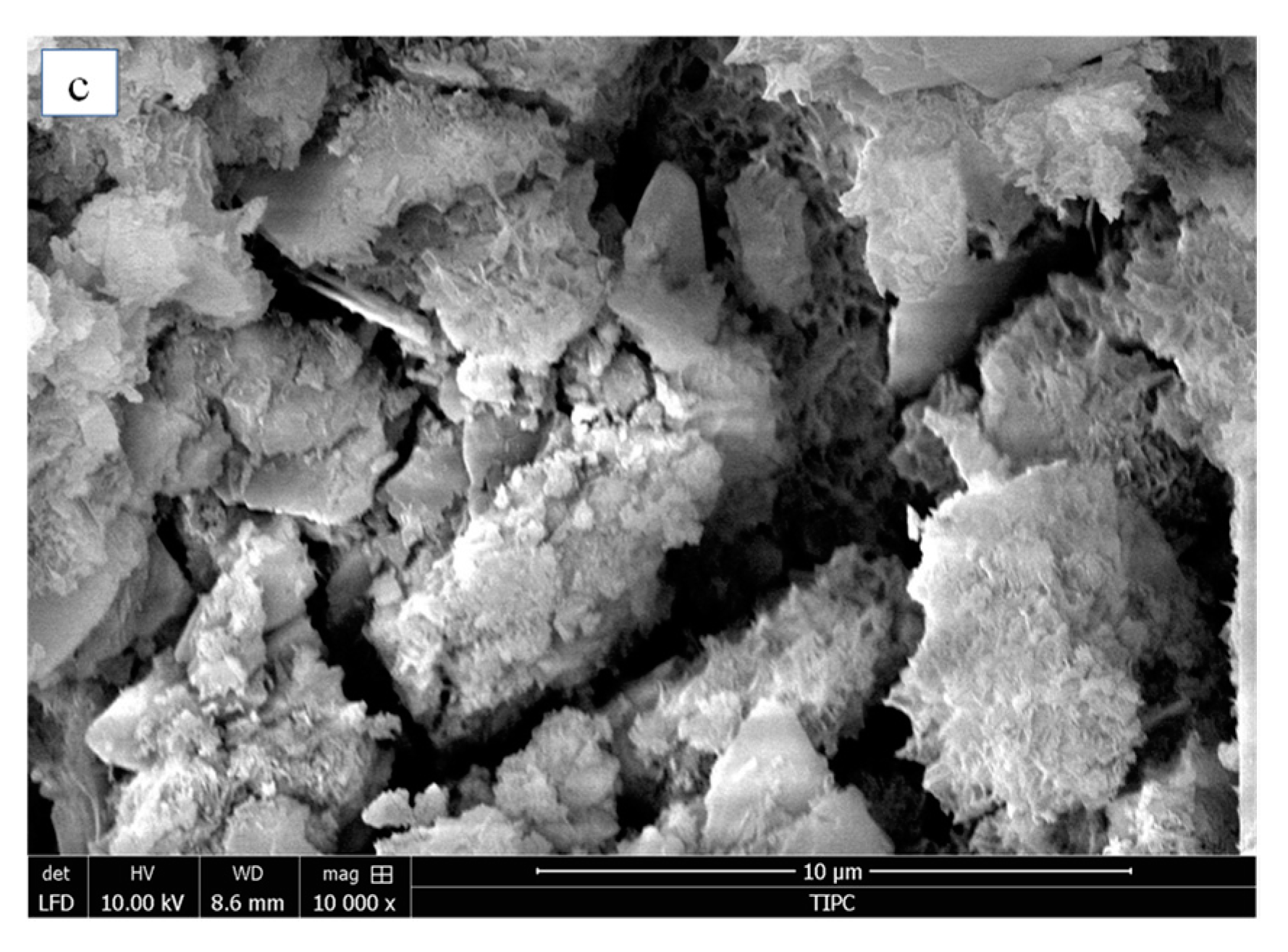

| Composition | Content | Composition | Content | Composition | Content |
|---|---|---|---|---|---|
| SiO2 | 79.770% | MgO | 2.040% | H2O | 0.061% |
| Al2O3 | 2.540% | Cao | 2.780% | TiO2 | 0.098% |
| Fe2O3 | 8.040% | Na2O | 0.310% | P2O5 | 0.050% |
| FeO | 1.160% | K2O | 0.670% | MnO | 0.013% |
| Type | MgO (%) | CaO (%) | SiO2 (%) | Al2O3 (%) | Fe2O3 (%) | SO3 (%) | Relative Density | Specific Surface (m2/g) |
|---|---|---|---|---|---|---|---|---|
| PCI | 2.65 | 62.82 | 18.03 | 4.53 | 2.70 | 3.82 | 3.10 | 1.30 |
| Element (unit) | Sp (m2/g) | Gs (-) | S (wt%) | Ca (wt%) | Si (wt%) | Al (wt%) | Mg (wt%) | Fe (wt%) | Si/Ca |
|---|---|---|---|---|---|---|---|---|---|
| PCI | 1.32 | 3.15 | 1.5 | 44.9 | 8.4 | 2.4 | 1.6 | 1.9 | 0.2 |
| Sample No. | Curing Temperature | Curing Time (days) | Binder-to-Water Ratio (w/c) | Solid Content/% | Number of Samples |
|---|---|---|---|---|---|
| C472 | 25 °C | 3, 7, 28 | 1/4 | 72% | 10 |
| C475 | 25 °C | 3, 7, 28 | 1/4 | 75% | 10 |
| C478 | 25 °C | 3, 7, 28 | 1/4 | 78% | 10 |
| C672 | 25 °C | 3, 7, 28 | 1/6 | 72% | 10 |
| C675 | 25 °C | 3, 7, 28 | 1/6 | 75% | 10 |
| C678 | 25 °C | 3, 7, 28 | 1/6 | 78% | 10 |
| C872 | 25 °C | 3, 7, 28 | 1/8 | 72% | 10 |
| C875 | 25 °C | 3, 7, 28 | 1/8 | 75% | 10 |
| C878 | 25 °C | 3, 7, 28 | 1/8 | 78% | 10 |
| C1072 | 25 °C | 3, 7, 28 | 1/10 | 72% | 10 |
| C1075 | 25 °C | 3, 7, 28 | 1/10 | 75% | 10 |
| C1078 | 25 °C | 3, 7, 28 | 1/10 | 78% | 10 |
| Sample No. | UCS /MPa | Increment Values /MPa | Increment Rate of UCS /(MPa·day−1) | ||||||
|---|---|---|---|---|---|---|---|---|---|
| 3 d | 7 d | 28 d | 0–3 d | 3–7 d | 7–28 d | 0–3 d | 3–7 d | 7–28 d | |
| C472 | 0.6 | 1.4 | 2.5 | 0.6 | 0.8 | 1.1 | 0.20 | 0.20 | 0.05 |
| C672 | 0.4 | 0.8 | 2.1 | 0.4 | 0.4 | 1.3 | 0.13 | 0.10 | 0.06 |
| C872 | 0.35 | 0.4 | 1.4 | 0.35 | 0.05 | 1.0 | 0.11 | 0.01 | 0.05 |
| C1072 | 0.25 | 0.3 | 1.0 | 0.25 | 0.05 | 0.7 | 0.08 | 0.01 | 0.03 |
| C475 | 0.9 | 2.1 | 3.9 | 0.9 | 1.2 | 1.8 | 0.30 | 0.30 | 0.08 |
| C675 | 0.5 | 1.3 | 3.5 | 0.5 | 0.8 | 3 | 0.17 | 0.20 | 0.14 |
| C875 | 0.4 | 0.7 | 1.8 | 0.4 | 0.3 | 1.4 | 0.13 | 0.08 | 0.07 |
| C1075 | 0.3 | 0.6 | 1.1 | 0.3 | 0.3 | 0.5 | 0.10 | 0.08 | 0.02 |
| C478 | 1.1 | 3.0 | 5.0 | 1.1 | 1.9 | 2 | 0.37 | 0.48 | 0.10 |
| C678 | 0.6 | 1.9 | 3.8 | 0.6 | 1.3 | 1.9 | 0.20 | 0.33 | 0.09 |
| C878 | 0.5 | 1.4 | 2.4 | 0.5 | 0.9 | 1 | 0.17 | 0.23 | 0.05 |
| C1078 | 0.4 | 0.7 | 1.3 | 0.4 | 0.3 | 0.6 | 0.13 | 0.08 | 0.03 |
| Sample No. | UCS Equation Exponent (y = c + a·ebx ) | Correlation Coefficient (r) | Equation Number |
|---|---|---|---|
| C472 | 0.9478 | 1 | |
| C672 | 0.99 | 2 | |
| C872 | 0.984 | 3 | |
| C1072 | 0.996 | 4 | |
| C475 | 0.975 | 5 | |
| C675 | 0.89 | 6 | |
| C875 | 0.914 | 7 | |
| C1075 | 0.911 | 8 | |
| C478 | 0.897 | 9 | |
| C678 | 0.8735 | 10 | |
| C878 | 0.989 | 11 | |
| C1078 | 0.964 | 12 |
| Sample No. | tcomputed | ttabulated | Fcomputed | Ftabulated | Equation Number |
|---|---|---|---|---|---|
| C472 | 8.4 | ±1.833 | 119.06 | ±3.18 | 1 |
| C672 | 19.84 | ±1.833 | 263.5 | ±3.18 | 2 |
| C872 | 15.62 | ±1.833 | 299.18 | ±3.18 | 3 |
| C1072 | 31.52 | ±1.833 | 159 | ±3.18 | 4 |
| C475 | 12.41 | ±1.833 | 155.2 | ±3.18 | 5 |
| C675 | 5.52 | ±1.833 | 53.5 | ±3.18 | 6 |
| C875 | 6.37 | ±1.833 | 53.9 | ±3.18 | 7 |
| C1075 | 6.24 | ±1.833 | 75.2 | ±3.18 | 8 |
| C478 | 5.73 | ±1.833 | 61.47 | ±3.18 | 9 |
| C678 | 5.07 | ±1.833 | 36.55 | ±3.18 | 10 |
| C878 | 18.91 | ±1.833 | 550 | ±3.18 | 11 |
| C1078 | 10.25 | ±1.833 | 207.3 | ±3.18 | 12 |
Publisher’s Note: MDPI stays neutral with regard to jurisdictional claims in published maps and institutional affiliations. |
© 2022 by the authors. Licensee MDPI, Basel, Switzerland. This article is an open access article distributed under the terms and conditions of the Creative Commons Attribution (CC BY) license (https://creativecommons.org/licenses/by/4.0/).
Share and Cite
Tian, X.; Xu, W. Prediction of the Mechanical Performance of Cemented Tailings Backfill Using Ultrasonic Pulse Velocity Measurement. Minerals 2022, 12, 986. https://doi.org/10.3390/min12080986
Tian X, Xu W. Prediction of the Mechanical Performance of Cemented Tailings Backfill Using Ultrasonic Pulse Velocity Measurement. Minerals. 2022; 12(8):986. https://doi.org/10.3390/min12080986
Chicago/Turabian StyleTian, Xichun, and Wenbin Xu. 2022. "Prediction of the Mechanical Performance of Cemented Tailings Backfill Using Ultrasonic Pulse Velocity Measurement" Minerals 12, no. 8: 986. https://doi.org/10.3390/min12080986
APA StyleTian, X., & Xu, W. (2022). Prediction of the Mechanical Performance of Cemented Tailings Backfill Using Ultrasonic Pulse Velocity Measurement. Minerals, 12(8), 986. https://doi.org/10.3390/min12080986






